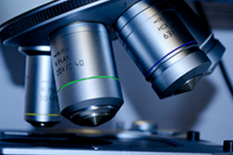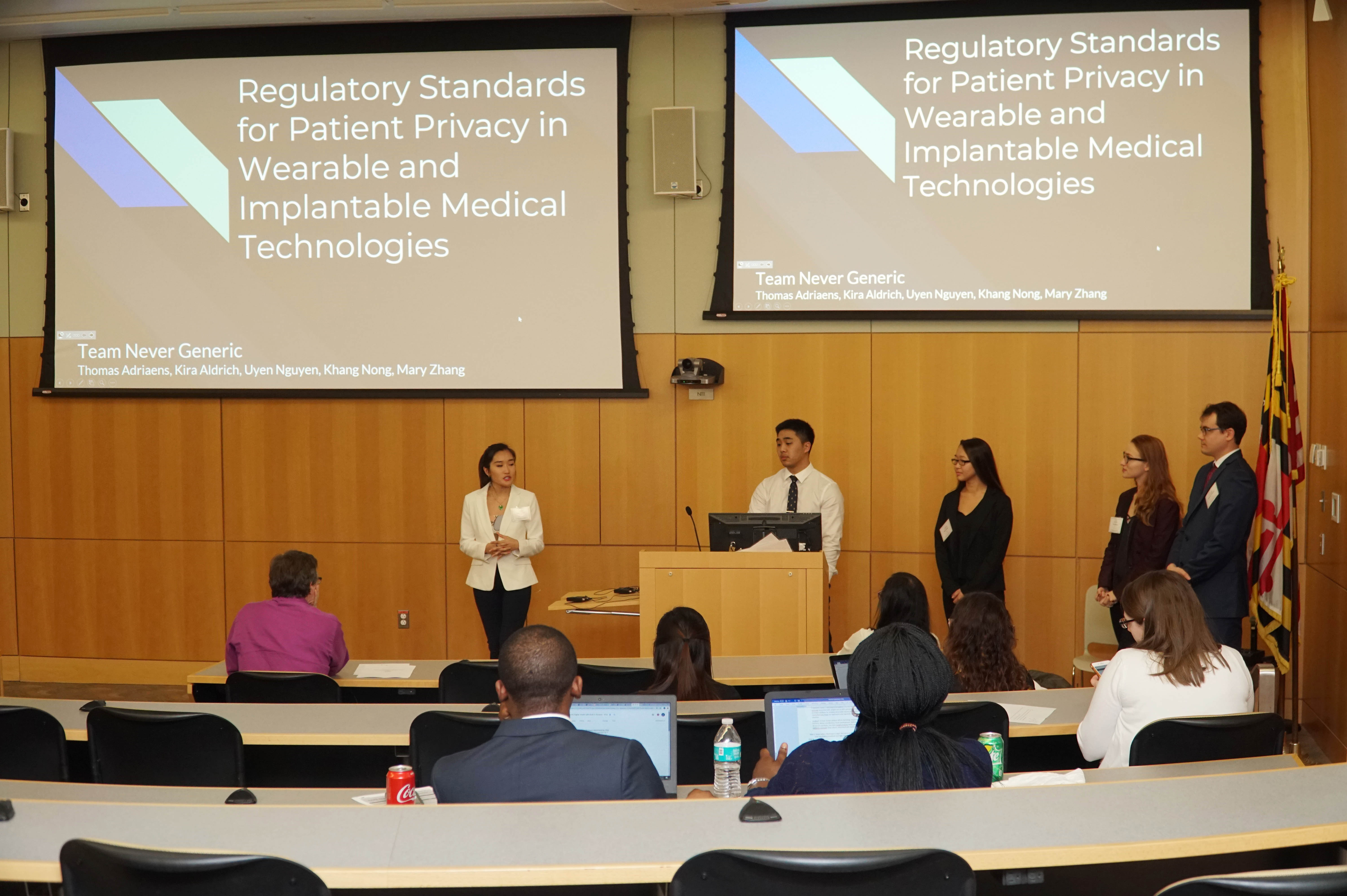News Story
Student Competition Spotlights Innovation in Regulatory Science

By Malissa Carroll
With the advent of new wearable and implantable devices that can monitor many aspects of an individual’s health – from resting heart rate to fall detection – it should come as no surprise that the once disparate fields of health care and technology are now beginning to converge. In June 2018, the U.S. Food and Drug Administration (FDA) approved the first continuous glucose monitoring system with a fully implantable glucose sensor and compatible mobile app for use by adults with diabetes, further signaling patients’ demands for new, innovative tools to help manage their chronic diseases. Yet, the increasing popularity of these emerging technologies has led to questions surrounding the collection of health care data and patient privacy that neither health care providers, device manufacturers, nor regulatory agencies have been able to answer.
Confronted with this unmet need, a team of third-year students in the Doctor of Pharmacy (PharmD) program at the University of Maryland School of Pharmacy set out to develop new guidelines that could be used by the FDA to help draft official guidances and recommendations that establish ownership rights for data collected by these wearable and implantable health care devices, as well as give patients broad control over how that data is shared and used by others. Team members Thomas Adriaens, Kira Aldrich, Uyen Nguyen, Khang Nong, and Mary Zhang presented their proposal to a panel of three judges from the School of Pharmacy at this year’s “America’s Got Regulatory Science Talent” Competition on Feb. 6, who awarded them first place for their innovation and creativity.
“In recent decades, we have witnessed the exponential growth of wireless devices to help people communicate, manage their finances, control their home environment, and now, manage their health information,” said Nguyen. “With this rapid growth also comes the expansion of medical technology, particularly in the area of implantable and wearable devices. And, while these medical innovations are incredible, there remains a lot of ambiguity around the ownership, transaction, and use of the health information these devices collect.”
She added, “The guidelines that we proposed today provide a mechanism by which the FDA can begin to help patients and providers manage this information.”
Speaking after Nguyen, Nong described the two-part approach the team used to develop its guidelines, examining the problem from both a health information perspective and a cybersecurity perspective. He noted how patients’ health information is currently protected under both the Health Insurance Portability and Accessibility Act (HIPAA) and the Privacy Rule, and spoke about the FDA’s existing guidances and recommendations surrounding cybersecurity measures for medical devices.
Nong also explained the limitations of these existing policies, and the important gaps that could be filled by the guidelines his team members developed. “There remains a need to establish a bridge between the current policies that helps patients better understand their rights related to the collection, storage, and dissemination of their health information, while also placing limits on the rights held by the companies that developed the technology,” he said.
Nguyen, Nong, and their team members created five guidelines for the FDA to consider when drafting guidances and recommendations related to the health information collected by implantable and wearable medical devices. The guidelines included: (1) Any patient health information collected from implantable monitoring devices is the sole property of the health care provider or system responsible for the monitoring and therapeutic management of the patient; (2) Release of patient information to new or previously unauthorized parties is under patient discretion and requires a supplemental form detailing the recipients of the data and its intended uses to be signed by the patient; (3) Collected data and patient information is protected under HIPAA and the Privacy Rule; (4) Medical device manufacturers must be compliant with all cybersecurity regulations and are subject to annual FDA checks; and (5) These data may not be considered by insurance companies when determining coverage.
“Our goal in developing these recommendations is to better prepare the FDA for the future,” concluded Nguyen. “Further increases in the development of wireless medical devices are imminent, and the market will only continue to grow as time progresses.”
Judges Ryan M. Pearson, Ph.D., assistant professor in the Department of Pharmaceutical Sciences (PSC) at the School of Pharmacy; Amanda Oglesby-Sherrouse, PhD, associate professor in PSC; and SeJeong Yoon, PharmD ’18, postdoctoral fellow in regulatory and medical affairs at the School, agreed with the team, awarding its members first place and the chance to meet with staff at the FDA to further discuss their proposal.
Four teams competed in this year’s talent competition. Second place was awarded to PhD in PSC graduate students Ana Coutinho, Angela Lee, Bryan Eng, Dongyue Yue, Sharmila Das, and Yuwei Lu for their proposal to define a standard puff for first generation e-cigarettes, which could better equip the FDA to evaluate the safety of all first generation e-cigarettes against a common standard.
Second-year student pharmacist Yanhong “Alice” Lu also presented a proposal to improve excipient pharmacovigilance (monitoring side effects caused by inactive ingredients) among generic drugs, while husband-and-wife team Abimbola Onasanya, a student in the MS in Regulatory Science program, and Oluwadamilola Onasanya, a graduate student in the PhD in Pharmaceutical Health Services Research program at the School, delivered a presentation advocating for the use of digital sensors to resolve pharmacokinetic, therapeutic consistency, and safety challenges in clinical trials for medical marijuana products.
“The ‘America’s Got Regulatory Science Talent’ Competition is one of my favorite student events,” says James Polli, PhD, the Shangraw/Noxell Endowed Chair in Industrial Pharmacy and Pharmaceutics at the School and co-principal investigator at the University of Maryland Center of Excellence in Regulatory Science and Innovation (M-CERSI), which sponsored the competition. “It’s an event that takes students beyond the curriculum that we teach in the classroom, introducing them to the vital role that regulatory science plays in all that we do in drug discovery and development. I continue to be impressed by the time and dedication that our students commit to their proposals.”
Individuals who are interested in pursuing or advancing their career in the field of regulatory science are encouraged to explore the online Master of Science and Graduate Certificate in Regulatory Science programs offered at the School of Pharmacy.
This article was originally featured on the University of Maryland School of Pharmacy website.
View Team Never Generic's presentation and Team Crown JUULs' presentation online. Read the team member bios to learn more.
Published March 15, 2019









